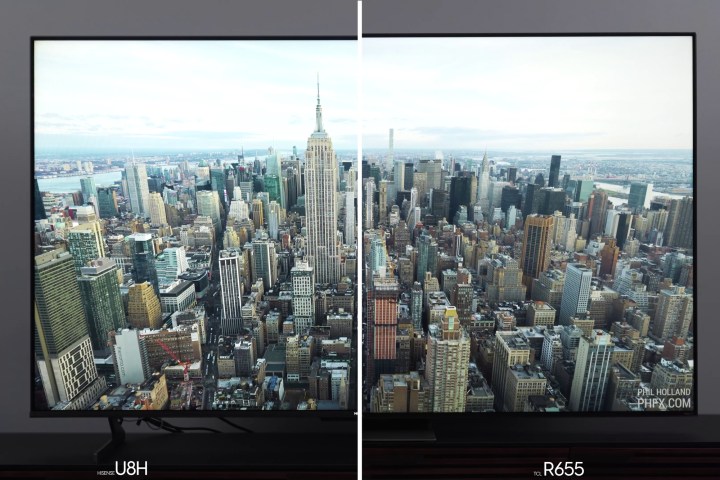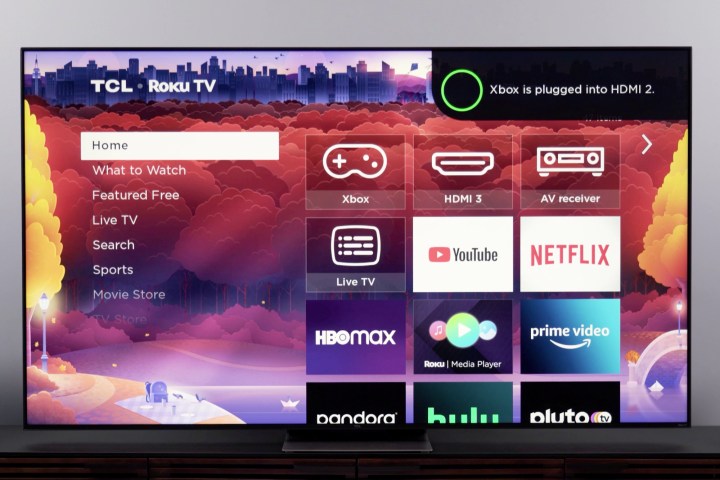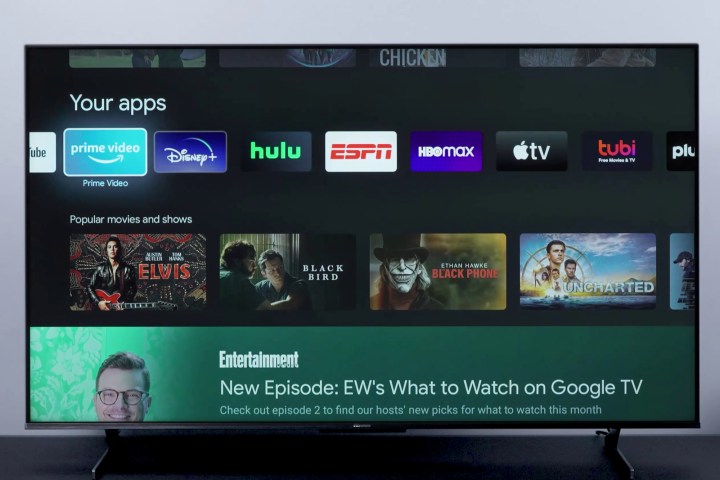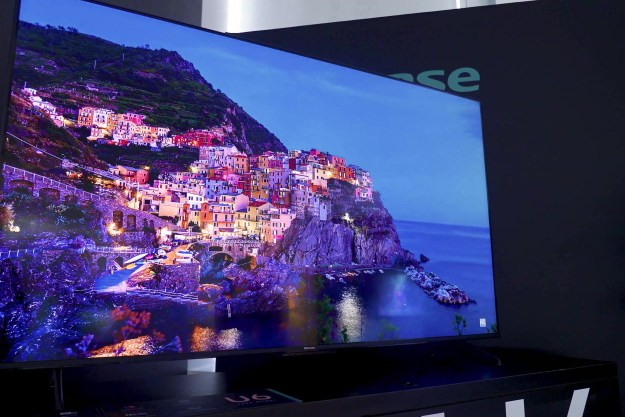I consider both the Hisense U8H and TCL 6-Series (R655) to be the two best bang-for-your-buck TVs on the market this year. That being the case, I suspect a lot of shoppers will struggle to decide between the two, but this article should help. I’ve broken down the strengths and weaknesses of both TVs and identified which TV might suit some common use cases.
There’s plenty to go through, so let’s just get to it, shall we?
Video head-to-head
Under the hood
Before we get into picture quality comparisons, we need to start with the software these TVs are built on. These smart TV platforms don’t just influence the overall experience of living with these TVs, how easy it is to find the content you want to watch, or how quickly your apps load. They also influence picture quality.
The Hisense U8H runs Google TV, and the TCL runs Roku TV. On the Google TV platform — which also see on Sony TVs — there aren’t many restrictions imposed by the platform itself.
The Roku TV platform, meanwhile, is much more limited in terms of how much control you can have over the picture it puts out. Furthermore, some of the more granular controls that are available can’t be used without the
For a Roku TV like the TCL 5-Series or 4-Series, or even some of the lower-end TVs like Hisense’s
Brightness
It likely won’t come as a surprise that the Hisense U8H is, on balance, a brighter TV. And it’s not just the peak brightness for HDR highlights that’s brighter — it’s bright all the time. Whether that’s good for you is something I’ll get to below. But for now, if we accept that the Hisense U8H is a bright TV, we naturally want to find out how the TCL 6-Series compares. Figuring that out has taken a lot of my time.
I ran a comparison of HDR content simultaneously on both TVs using their built-in YouTube app. The Hisense picture preset was set at Filmmaker mode, though I got similar results with
So, while it’s nice to have this quick way to just brighten things up, maybe depending on whether you’re watching in the dark, or on a gloomy day, or a really bright day, this kind of goes against the idea of having backlight control at all. Not only that, but within the Dark HDR picture mode, it appears that there are limits on just how bright it will go. In the “normal
The issue I have with that is that you give up on some of the other accuracy-focused settings found in Dark HDR when you move to the normal
That makes it hard to do an apples-to-apples comparison between these two TVs, but I do feel like the brightest setting in the TCL’s Dark HDR preset does get fairly close to the Hisense U8H without skewing a bunch of other picture quality elements.

I think a lot of people want dazzle, and the Hisense U8H delivers a bit more of that than the TCL 6-series.
When comparing brightness with an eye to preserving picture quality, what we see is that the U8H is a brighter, zingier TV. There’s more pop. It also has higher contrast than the TCL. The TCL, by comparison, is a bit more reserved, but it also looks a lot more realistic, which you could also call more accurate. The colors on the TCL aren’t artificially over-driven to the naked eye, and by the measurements I took, the TCL is indeed more accurate.
But I don’t think that accuracy is what a lot of folks are looking for. I think a lot of people want dazzle, and the Hisense U8H delivers a bit more of that than the TCL 6-series. In a side-by-side comparison, I think non-experts would say the Hisense looks better when playing HDR content, at least from a sheer brightness and contrast perception perspective. But the U8H does have some issues that might unwind that enthusiasm.
For example: In HDR especially, the U8H has a processing issue that causes shimmer in highly detailed portions of an image with bright highlights on YouTube. When there’s motion, you get a shimmer artifact on the U8H that you don’t get on the TCL 6-Series. Also, again in
That’s HDR. But what about SDR? It should come as no surprise that the Hisense can be a lot brighter than the TCL, but what stands out to me is that, in the Movie mode, even with the brightest setting turned on, the TCL is not getting anywhere near as bright as it could. That makes sense for movie mode, but it lacks contrast; there’s not enough pop. Yet, in Normal mode, I found it to be a bit brighter, and the perceived contrast is much better. However, the color temperature was way off, and there was motion smoothing I needed to fix. Ultimately, I had to change modes and manually adjust levels across three menus to end up with a picture close in brightness and accuracy to the U8H.
Why it continues to take so much work to get to what I want escapes me, but I don’t blame TCL. I think it is probably a Roku TV platform thing. I just wish it wasn’t this way.
Picture Quality
Moving on to motion resolution in general: the TCL R655 is better. It has smoother, more natural motion with fewer artifacts than the U8H, even without the HDR shimmer I mentioned before.
As for blooming control, neither TV is significantly better than the other. Both TVs have excellent backlight control in general, and both do a great job of mitigating most bloom. While some other, more expensive TVs might provide better blooming control, for the purposes of this comparison, it is a draw.
The TCL is a more natural-looking TV, and it can still dazzle you when it should.
So, what’s the takeaway on picture quality? The Hisense U8H is a more dazzling TV. Its juiced-up brightness, color saturation, and dark darks give it eye-popping contrast. Many folks seeing these TVs side-by-side would say the Hisense is the “better” TV, at least at first. It’s more appetizing looking. And by that, I mean I watched a lot of content with beautiful food footage, and the same footage playing on both TVs looked more appetizing on the Hisense. It makes you want to eat the picture. The drawback is that it’s not as natural looking. And less natural, in my book, means less realistic.
The TCL is a more natural-looking TV, and it can still dazzle you when it should. Not only that, it doesn’t suffer from overly darkened dark areas, nor does it have the motion shimmer we saw in the Hisense U8H. Its motion resolution also is smoother and more pleasing to the eye. It’s not quite as bright as the Hisense U8H, but it can still get plenty bright for most use cases. And for general image processing, the TCL is doing a better job overall.
Gaming
First, let me say that I think there are more qualified opinions out there about which might be the better TV for gaming from a deep-dive perspective. However, I will say, from a user standpoint, I like some of the recognition and automation the TCL 6-Series provided when I connected my Xbox Series X console, and I like that it can go up to 144Hz.
Other than that, it’s a draw. They use the same chipsets, have the same connectivity, and have the same slight limitations. For the casual gamer, either one of these TVs will satisfy.
Sound quality and looks
It’s no contest: The Hisense U8H beats the pants off the TCL R655. The TCL 6-Series just doesn’t have very good audio, while the Hisense has surprisingly robust sound. As for looks? Take your pick. The central stand on the TCL; the versatile legs on the Hisense. This is really down to whatever works best for you.
The last thing I want to point out is that the TCL R655 is available in an 85-inch model, whereas the Hisense U8H tops out at 75.
The takeaway
So which TV is best? That depends on what you want. If you want a TV with a lot of bling and are willing to look past some shortcomings to get it, the Hisense U8H is arguably the more dazzling TV. It also has better sound, and it runs Google TV if either of those steers you in a certain direction.
If you want a more reserved TV that has a bit more finesse, the TCL R655 is the better choice. It can also get very bright, but you have to work harder to get it to do what you want, and even then, there are some levers for adjustments that you will not be able to touch. You’ll need to be ok with that.
Which one would I personally pick for my home? With my particular needs and preferences that are all unique to me, I’d go for the TCL between these two, but that should not necessarily be your decision. Weigh everything you’ve learned today and make the best choice for you.
In the end, these TVs are both winners in my book. You’re getting stellar performance at prices that are well below what you’d expect for the picture quality. It’s nice to be able to have to make such a tough decision.
Editors' Recommendations
- These 43-inch 4K TVs are under $200 at Walmart
- This 58-inch TV is discounted to $258, and it’s flying off the shelves
- Snag yourself a 58-inch 4K TV for $268 before it’s too late
- TCL QM8 vs. Hisense U8K: budget battle royale
- Hisense kicks off its U8K mini-LED TV availability with deep discounts








